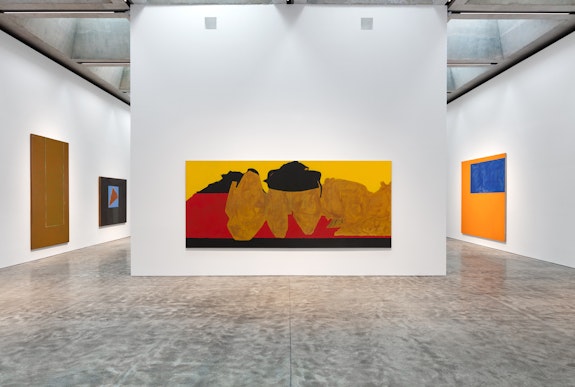ArtSeen
Sheer Presence: Monumental Paintings by Robert Motherwell
New York
Paul Kasmin GalleryMarch 21 – May 18, 2019
Those of us weaned on the history of contemporary American painting will recognize the drips and pours of Pollock, the brushwork of De Kooning, the colors of Rothko, the marks of Mitchell, the zips of Newman, the gestures of Kline—but what do we associate with the paintings of Robert Motherwell? Of the many words that come to mind, the most inclusive choice would be “aesthetics,” a term for beauty expropriated from the Enlightenment, but this does not exactly fit the scheme of elocutions given to the other artists.
In Sheer Presence, an extant selection of eight large-scale paintings (some borrowed from The Dedalus Foundation, established by the artist in 1981) Motherwell’s impassioned quest for beauty is revealed, particularly in a work such as The Forge (1965–1966 / 1967–1968) where it is unobtrusively clear. Following his approach to form and spatial/gestural awareness in The Grand Inquisitor (1989–1990), which one confronts directly upon entering the gallery, and Open No. 97, The Spanish House (1969), we encounter two paintings in which the artist’s desire gives a further ineluctable perfection to the surfaces, despite their acute formal differences.
In some ways, Sheer Presence—a term quoted from an interview with the artist in 1964—is comparable in its intention to other exhibitions seen throughout Europe during the artist’s late career, but also including the artist’s first New York retrospective at The Museum of Modern Art (1965), brilliantly curated by the aesthete/poet Frank O’Hara.
For an adolescent painter/critic, this MoMA exhibition—seen many, many years ago—was a transformative one that explained the pleasure and dynamic of abstract painting through a language of its own, a quality that some viewers (including myself) might rediscover in the current exhibition, though necessarily on a smaller scale. Motherwell made a clear distinction between painting large and small. They were two different kinds of experience, the former being the focus in the present exhibition.
Among all the major Abstract Expressionist painters, Robert Motherwell is perhaps the least understood relative to his stylistic approach to painting. I use the word style—not sparingly—given that his stylistic consistency is essential to his work. Those who misunderstand tend to pluralize the word as if the artist had an arsenal of ‘styles’ that shifted from one to another. This is inaccurate. Motherwell had one style, a single style that he perfected throughout his highly prolific and intensely sensitized career.
In more contemporary terms, we might identify Motherwell’s approach to painting as possessed by a tactile sensation made visible throughout his oeuvre, no matter what the scale or medium, whether painting or collage. His linear trace reveals an authentic, if not indelible quality. Comparatively speaking, the delineation of the bulky oval forms in The Grand Inquisitor possesses a plasticist quality of execution similar to that of the more casual window geometry found in Open in Grey with White Edge (1971). This quality of line and surface enunciation is apparent throughout the Elegies to the Spanish Republic and the Open series and other works that display an autonomously textured surface. This would include the painting, Hoppla, wir leben! (1971/ca. 1974–1977), where a densely painted ultramarine rectangle appears near the upper right corner of an ochre field. While Hoppla appears indigenous to the Open series (which began formally in 1967), Motherwell was known to paint monochrome ochre surfaces that would remain in his studio for months before finding a significant direction toward completion.
This quality of line, consistently used throughout the artist’s work, along with the trace of his brush over a large surface area, is designated as style. In other words, the viewer detects a sensory presence that is consistent from one painting to the next. Nowadays, this approach to painting is less evident than in the recent past, especially when the task of painting is hired out for others to perform. In Motherwell’s case, there was no performance other than the direct act of painting. Therefore, given the artist’s automatist proclivity, the development of a painterly style was as much an unconscious as a thoroughly conscious engagement.
There is little doubt that Motherwell’s visits to southern Europe in his early career, particularly to Spain and France, played a definitive role in his development of an aesthetic whereby the development of an intrinsic style of painting was considered essential. What differentiates Robert Motherwell’s paintings from other Abstract Expressionist painters was his brilliant merging of a southern European style of painting with the “sheer presence” of an American large-scale format. There is no doubt that the scale of the Elegies presented in the early MoMA exhibition made this clear. Motherwell’s elegance as a painter accompanied by his gallant approach to serious scholarship is, for the most part, beyond the pale for painters in recent years. The fact that Motherwell saw his role as a combination of philosopher/aesthetician and exemplary painter was an extraordinary feat and what finally signifies the essence of Motherwell.



